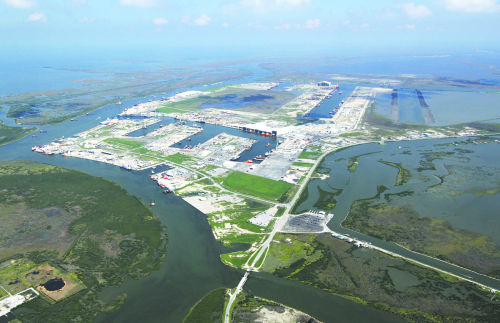
Willie W. Bonvillain
November 20, 2013
Patterson still alive after hard-fought victory
November 27, 2013Geographic advantages that contributed to economic growth in Lafourche over the last 10-plus years are but one end of a double-edged sword simultaneously threatening to derail the progress.
Subsiding land and uncertainty as to future flood-insurance premiums counterbalance a proximity to the Gulf of Mexico, a rail line, four-lane highway and multiple airports. Hurricanes, which bring with high winds and rain an economic infusion during rebuilding efforts, are another lingering concern for residents and potential migrants.
For now the trump card remains Port Fourchon, which can’t seem to expand quickly enough to keep up with interest. Fourchon is the base for about 90 percent of service activities in the deep-water Gulf of Mexico, where oil-and-gas analysts are consistently projecting a protracted boom in development.
Bustling at the southernmost portion of Lafourche has wide-reaching impacts on the rest of the parish’s business community, Parish President Charlotte Randolph said.
“What happens when you have the success of a major sector such as oil and gas, then the other industries in the parish flourish, including medical care,” Randolph said. “That allows for a Thibodaux Regional to service a larger number of people because so many people are insured through the industry.”
Lafourche saw job growth at a rate of 13 percent from 2005 to 2010, a figure that nearly doubled the state’s pace, according to the U.S. Bureau of Economic Analysis.
And from 2002 to 2012, the parish’s per-capita personal income level nearly doubled, increasing from $26,000 to $46,000 over that decade, while population grew at a 6-percent rate over the same period.
Those changes were similar in Terrebonne Parish: Personal income per capital jumped from $23,000 in 2002 to $41,000 in 2012, while population grew at a 6 percent rate. In St. Mary, per-capita income rose from $24,000 to $38,000, and the population increased by 1 percent.
Of the job growth in Lafourche, almost all 7,000 added positions came in the private sector. Businesses in the parish employed roughly 60,000 people in 2010, according to the figures.
In order to maintain an environment that allows economic growth, the parish has to convey to investors that their money will be protected, which entails elevation of the south Lafourche ring levee system and improving flood protection in other areas of the parish, Randolph said.
Randolph said the Larose-to-Golden Meadow levee system’s sterling reputation contributed to Chevron’s $29 million investment in a worker transfer facility at the South Lafourche airport.
Ongoing efforts to establish for the first time a parishwide comprehensive resiliency plan have led to a thorough surveying of the parish’s strengths and weaknesses and projection of future developments.
Included in the draft plan, updated this month, is a suggestion that Lafourche capitalize on its lack of retail offerings to compete for shoppers who currently travel throughout the region to Terrebonne Parish. Raceland, specifically, is mentioned as a possibility, because of its proximity to U.S. Highway 90 and the anticipation the town “will experience significant development in the future.”
Aside from retail, Lafourche has relatively lower employment levels in accommodation and food and health care when compared to state averages, according to the comprehensive plan’s steering committee report.
Raceland is also the site of an announced $75 million investment in a new crude oil transfer facility by Houston-based Genesis Energy. The facility will intake oil via existing rail lines, store it in tanks and inject it in pipelines connected to refineries. The facility will create roughly 20 jobs and use mostly existing infrastructure.
“The confluence of rail and the four-lane highway in the central part of the parish is something that makes Lafourche attractive to other businesses,” Randolph said.
Portland, Ore.-based Fregonese Associates was contracted to assist with the study, a $257,000 undertaking mostly funded with state dollars.
It is nonbinding and includes no regulations, but Randolph said the parish would work toward incorporating its findings alongside the master drainage plan, a prioritized list of $141 million worth of rainwater-drainage projects throughout the parish published last summer.
Looming large over Lafourche and coastal counties across the nation is the Biggert-Waters Act, a reform bill passed by Congress in 2012 that has delivered higher flood-insurance premiums to homeowners, in some cases at an unaffordable rate. If enacted as written, parish officials worry that it have a deleterious impact on the housing market, as homeowners would be saddled with unsellable properties and banks would be forced to foreclose on mortgaging homeowners who do not maintain flood insurance.
Randolph said she remains “cautiously optimistic” that the local Congressional delegation, part of a larger coalition of mostly coastal lawmakers, would succeed in at least delaying Biggert-Waters.
“Our conference call on Friday indicated the number of signatories on the bill to delay (Biggert-Waters) for four years until a reasonableness study can be completed, that list continues to grow,” Randolph said. “It’s a significant number in both the House and the Senate, and the education campaign is also working.”
Should the bipartisan legislation continue to be enacted as scheduled, Lafourche residents could see their insurance premiums skyrocket.
The federal law aimed to make the National Flood Insurance Program solvent, and among its changes is the stripping of subsidies and grandfathered rates for some people based on their properties’ relativity to base flood elevation rather than flood history.
That Lafourche previously received no credit for levees and structures that stem the threat of tidal surges because the systems did not meet federal standards tightened after Hurricane Katrina had threatened to exacerbate increases to premiums.
But the parish is one of 25 across the country selected to pilot the FEMA’s Levee Analysis and Mapping for Non-Accredited Levees program, which aims to determine a method to recognize non-accredited flood protection.
Another issue facing Lafourche Parish in the near term is its dilapidated and overcrowded detention center.
Voters rejected a proposal a week and a half ago that would have rerouted library revenue toward construction of a new jail, estimated then to cost $25 million. Officials have said they’re worried a federal mandate could be handed down if the jail woes aren’t solved soon. That would tie up parish resources and give Lafourche little flexibility in how it can approach the problem.
Randolph said she would work alongside the sheriff and review studies previously commissioned to determine the parish’s goals and the best way to fund them.
“We would prefer not to” levy a new tax, Randolph said, but “all options are on the table.”
An arial photo of Port Fourchon shows just how much the parish has grown. The local port’s continued growth is one of many bright spots within the parish in the past year, according to Parish President Charlotte Randolph.













